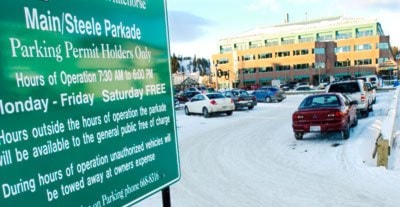Downtown office and store workers would have to stop snagging metered retail parking stalls before a downtown parkade was feasible.
That’s what the numbers indicate, said Mayor Bev Buckway after reviewing a parkade study released Thursday.
A parkade would only work if workers at the Royal Bank, Elijah Smith and Northwestel buildings stopped using metered spots, she said.
“A parkade would have to be for long-term employees and office workers,” she said.
“There’s really not a problem with the number of spaces (currently downtown); there’s a problem with how the spaces are used.”
Whether or not Whitehorse should consider a parkade all depends on how you look at the parking issue, said Jack Kobayashi, an architect who contributed to the city’s study.
Using Whitehorse’s current downtown parking bylaw, it has more than enough parking — 1,135 stalls more than it needs, he said.
If you apply the parking bylaw followed by the rest of town, the core has about 700 fewer spaces than required.
If Whitehorse followed BC Ministry of Transportation guidelines, the shortfall grows to 2,500.
Downtown retailers assert there’s not enough parking and it’s hurting business, said Kobayashi.
“The retailers still feel the amount of parking is a problem,” he said.
“They feel there is an unlevel playing field with Wal-Mart and the downtown core.
“They’re finding it tough to compete when it comes to parking.”
A parkade could be built, but it would be expensive, he said.
A ballpark estimate is $6.5 million — that’s $50,000 a stall in an unheated, open-aired three-storey lot with 130 stalls, according to the study.
That’s roughly 50 more stalls than exist downtown today.
The study said there is the possibility of up to five floors that would add another 120 lots, and push the cost to an estimated $12.5 million.
Build the parkade higher and it could accommodate more cars.
The current parking lot at Steele and Second Avenue has 80 lots — and a waiting list of 56 people trying to get them.
However, there are other benefits to a parkade, said Kobayashi.
It could provide new infrastructure and serve as a transportation hub for city buses.
It could also reduce parking in residential areas.
And if there was public buy-in, it could be self-financing, said Kobayashi.
Of course, it might also promote driving over bus service, ruin views and discourage people from walking, he added.
The city could make better use of its existing parking stalls if office workers at places such as the Elijah Smith building were allowed to park in the 100 stalls under that building occupied by government fleet-vehicles.
And, city officials should determine exactly how far a walk is too far because there are several free parking areas within a two- to six-block radius of Main Street, he said.
The city should do a follow-up study to pin down the exact cost of a parkade, added Kobayashi.
Councillor Dave Stockdale doesn’t want another study.
“When you get six reports that say we don’t need a parkade, I don’t really want to spend $100,000 on another study,” he said.
Councillor Jeanine Myhre said she couldn’t determine if a parkade was necessary, but she didn’t want to consider anything in the neighbourhood of a six-storey parking lot.
“I don’t really want to see the first six-storey building downtown being a parkade.”
The city has other options, said city manager Dennis Shewfelt.
It could purchase parking areas on the fringe of the downtown core and encourage people to park there and walk to work.
Other areas are getting away from parkades and downtown parking stalls in favour of more environmentally friendly options, he added.
“Calgary provides parking space at its LRT stations,” he said.
“If people want to drive downtown, they have to pay exorbitant prices.”
Council is set to discuss the study again in late February or early March.
